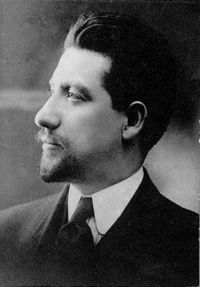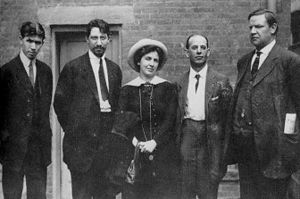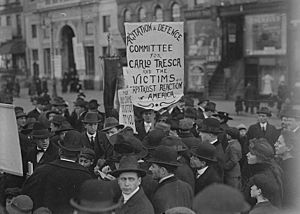Carlo Tresca facts for kids
Quick facts for kids
Carlo Tresca
|
|
|---|---|

Tresca in 1910
|
|
| Born | March 9, 1879 Sulmona, Italy
|
| Died | January 11, 1943 (aged 63) New York City, New York, U.S.
|
| Cause of death | Gunshot wound |
| Occupation | Newspaper editor and labor leader. |
| Children | Peter D. Martin |
Carlo Tresca (born March 9, 1879 – died January 11, 1943) was an Italian-American newspaper editor and a strong voice for workers' rights. He was a key leader in the Industrial Workers of the World during the 1910s. Tresca is remembered for bravely speaking out against powerful groups like fascism, Stalinism, and organized crime trying to control worker groups.
Born and raised in Italy, Tresca was an editor for a socialist newspaper and worked for railroad employees before he moved to the United States in 1904. He later joined the Industrial Workers of the World in 1912. He helped organize many strikes across the U.S. to improve conditions for workers.
In the 1930s, Tresca openly criticized both Benito Mussolini's Fascist government in Italy and Joseph Stalin's government in the Soviet Union. In 1937, he was part of a special group called the Dewey Commission. This group found that Leon Trotsky was innocent of charges made against him. Tresca also used his newspapers to speak out against organized crime. He was killed in New York in January 1943.
Contents
Early Life and Moving to America
Carlo Tresca was born on March 9, 1879, in Sulmona, Italy. His father was a landowner. Carlo went to secondary school, but his family did not have enough money for him to go to university. He briefly attended a seminary but left soon after. He became someone who did not believe in organized religion.
From 1898 to 1902, Tresca worked as the secretary for the Italian Federation of Railroad Workers. He was also the editor of a socialist newspaper called Il Germe. To avoid legal trouble for his strong political views, Tresca moved to the United States in 1904. He settled in Philadelphia.
Tresca had a son named Peter D. Martin. A sculptor named Minna Harkavy created a statue of him, which is now in his hometown of Sulmona.
Working for Change in America
In America, Tresca quickly became a leader. In 1904, he was chosen as the Secretary of the Italian Socialist Federation of North America. He held this job for three years. During this time, he also edited Il Proletario (The Proletarian), which was the official newspaper for the Italian Socialist Federation.
Tresca's ideas became even more focused on radical change. He began to see himself as an anarchist, someone who believes in organizing society without a government. In 1907, he left Il Proletario and started his own newspaper, La Plebe (The Plebeian). He later moved La Plebe to Pittsburgh. There, he shared his revolutionary ideas with Italian miners and factory workers. In 1909, Tresca became the editor of L'Avvenire (The Future). This newspaper was stopped during World War I because of a law called the Espionage Act.

Tresca joined the Industrial Workers of the World (IWW) in 1912. This group believed in workers taking control of their workplaces. The IWW asked him to help Italian workers during a strike in Lawrence, Massachusetts. He helped free strike leaders who were wrongly jailed. After this successful strike, Tresca helped with many other strikes across the United States. These included:
- The Little Falls, New York textile workers' strike (1912)
- The New York City hotel workers' strike (1913)
- The Paterson silk strike (1913)
- The Mesabi Range, Minnesota, miners' strike (1916)
He was arrested several times and spent nine months in jail while waiting for a trial related to the Minnesota strike. He was eventually released without a trial.
Tresca faced legal challenges and spent some time in prison in 1925.
Fighting Against Powerful Groups
Tresca became well-known among Italian-Americans for speaking out against fascism. Benito Mussolini, the leader of fascist Italy, saw Tresca as a major opponent. Tresca edited an anti-fascist newspaper called Il Martello. In it, he challenged the ideas that supported Mussolini's power.
The United States government watched Tresca closely and tried to send him out of the country. Mussolini's government also put pressure on the U.S. to ban Tresca's newspaper. The American government accused Tresca of publishing inappropriate content. Tresca was found guilty and faced deportation. However, many people protested, and U.S. President Calvin Coolidge stopped the deportation. Fascist groups tried to kill Tresca with a bomb in 1926, but he survived. Tresca played a big part in stopping Mussolini's ideas from spreading among Italian-Americans.
During the famous trial of Sacco and Vanzetti, Tresca helped organize public support, raise money, and find a lawyer for their defense.
In the 1930s, Tresca also became a strong critic of Soviet communism and Stalinism. He was especially upset after the Soviet Union worked to destroy the anarchist movement in Spain during the Spanish Revolution of 1936.
In 1937, Tresca was part of the Dewey Commission. This group investigated charges against Leon Trotsky and found him innocent.
In early 1938, Tresca publicly claimed that Soviet agents had kidnapped Juliet Stuart Poyntz. He believed they did this to stop her from leaving the Communist Party. Tresca said Poyntz had told him she wanted to "expose the communist movement" before she disappeared.
Assassination
On January 11, 1943, in New York City, Carlo Tresca was leaving an office when he got into a waiting car. Two hours later, Tresca was walking across Fifth Avenue when a black car stopped next to him. A gunman got out and shot Tresca in the back of the head, killing him instantly. The car was later found empty nearby.
At the time, some people thought the killer was a member of the Mafia. Others believed Tresca was killed by the Soviet secret police because he criticized Joseph Stalin's government.
It is said that Vito Genovese, a leader of a crime family, ordered Tresca's murder. The shooter was supposedly Carmine Galante. No one was ever charged with Tresca's murder.
Angelica Balabanoff, a socialist activist, gave a speech at his memorial service.
See also
 In Spanish: Carlo Tresca para niños
In Spanish: Carlo Tresca para niños
- List of unsolved murders
Images for kids





